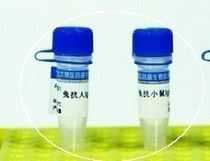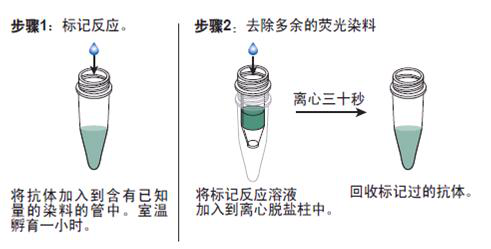
|

| 产地 | 进口、国产 |
| 品牌 | 上海莼试 |
| 保存条件 | Store at -20 °C |
| 货号 | CS10133 |
| 应用范围 | WB=1:100-500 ELISA=1:500-1000 IP=1:20-100 IHC-P=1:100-500 IHC-F=1:100-500 ICC=1:100-500 IF=1:100-500 |
| CAS编号 | |
| 抗体名 | Anti-Prion protein PrP |
| 克隆性 | |
| 靶点 | 详见说明书 |
| 适应物种 | 详见说明书 |
| 形态 | 详见说明书 |
| 宿主 | 详见说明书 |
| 亚型 | IgG |
| 标识物 | 详见说明书 |
| 浓度 | 1mg/1ml% |
| 免疫原 | KLH conjugated synthetic peptide derived from human Major prion protein |
抗体的生物素化标记实验要点:
1. 朊/感染性蛋白抗体费用 如在反应混合液中有叠氮钠或游离氨基存在,会抑制标记反应。因此,蛋白质在反应前要对 0.1mol/L碳酸氢钠缓冲液或0.5mol/L硼酸缓冲液充分透析;
2.所用的NHSB及待生物素化蛋白质之间的分子比按蛋白质表面的ε-氨基的密度会有所不同,选择不当则影响标记的效率,应先用几个不同的分子比来筛选最适条件;
3.用NHSB量过量也是不利的,抗原的结合位点可能因此被封闭,导致抗体失活;
4.由于抗体的氨基不易接近可能造成生物素化不足,此时可加入去污剂如 Triton x-100, Tween20等;
5.当游离ε-氨基(赖氨酸残基的氨基)存在于抗体的抗原结合位点时,或位于酶的催化位点时,生物素化会降低或损伤抗体蛋白的结合力或活性;
6.生物素还可能与不同的功能基团,如羰基、氨基、巯基、异咪唑基及*基,也可与糖基共价结合;
7.交联反应后,应充分透析,否则,残余的生物素会对生物素化抗体与亲和素的结合产生竞争作用;
8.在细胞的荧光标记实验中,中和亲和素的本底低,但由于链霉亲和素含有少量正电荷,故对某些细胞可导致高本底。
产品订购信息:
英文名称 Anti-Prion protein PrP
中文名称 朊/感染性蛋白抗体费用
别 名 AltPrP; ASCR; atal familial insomnia; CD230; CD230 antigen; CJD; Creutzfeld Jakob disease; Gerstmann-Strausler-Scheinker syndrome; GSS; KURU; Major prion protein; MGC26679; p27 30; PRIO_HUMAN; Prion protein; Prion related protein; PRIP; Prni; Prnp; PrP; PrP27 30; PrP27-30; PrP33 35C; PrP33-35C; PrPC; PrPSc; Sinc.


浓 度 1mg/1ml
规 格 0.2ml/200μg
抗体来源 Rabbit
克隆类型 polyclonal
交叉反应 Human, Mouse, Rat, Cow, Horse, Sheep
产品类型 一抗
研究领域 免疫学 神经生物学 干细胞 细胞凋亡 细胞表面分子 Alzheimer's
蛋白分子量 predicted molecular weight: 23kDa
性 状 Lyophilized or Liquid
免 疫 原 KLH conjugated synthetic peptide derived from human Major prion protein
亚 型 IgG
纯化方法 affinity purified by Protein A
储 存 液 Preservative: 15mM Sodium Azide, Constituents: 1% BSA, 0.01M PBS, pH 7.4
朊/感染性蛋白抗体费用 产品应用 WB=1:100-500 ELISA=1:500-1000 IP=1:20-100 IHC-P=1:100-500 IHC-F=1:100-500 ICC=1:100-500 IF=1:100-500
(石蜡切片需做抗原修复)
not yet tested in other applications.
optimal dilutions/concentrations should be determined by the end user.
保存条件 Store at -20 °C for one year. Avoid repeated freeze/thaw cycles. The lyophilized antibody is stable at room temperature for at least one month and for greater than a year when kept at -20°C. When reconstituted in sterile pH 7.4 0.01M PBS or diluent of antibody the antibody is stable for at least two weeks at 2-4 °C.
Important Note This product as supplied is intended for research use only, not for use in human, therapeutic or diagnostic applications.
产品介绍 The protein encoded by this gene is a membrane glycosylphosphatidylinositol-anchored glycoprotein that tends to aggregate into rod-like structures. The encoded protein contains a highly unstable region of five tandem octapeptide repeats. This gene is found on chromosome 20, approximately 20 kbp upstream of a gene which encodes a biochemically and structurally similar protein to the one encoded by this gene. Mutations in the repeat region as well as elsewhere in this gene have been associated with Creutzfeldt-Jakob disease, fatal familial insomnia, Gerstmann-Straussler disease, Huntington disease-like 1, and kuru. An overlapping open reading frame has been found for this gene that encodes a smaller, structurally unrelated protein, AltPrp. Alternative splicing results in multiple transcript variants. [provided by RefSeq, Oct 2012].
Function : May play a role in neuronal development and synaptic plasticity. May be required for neuronal myelin sheath maintenance. May play a role in iron uptake and iron homeostasis. Soluble oligomers are toxic to cultured neuroblastoma cells and induce apoptosis (in vitro). Association with GPC1 (via its heparin sulfate chains) targets PRNP to lipid rafts. Also provides Cu(2+) or ZN(2+) for the ascorbate-mediated GPC1 deaminase degradation of its heparan sulfate side chains.
Subunit : Monomer and homodimer. Has a tendency to aggregate into amyloid fibrils containing a cross-beta spine, formed by a steric zipper of superposed beta-strands. Soluble oligomers may represent an intermediate stage on the path to fibril formation. Copper binding may promote oligomerization. Interacts with GRB2, APP, ERI3/PRNPIP and SYN1. Mislocalized cytosolically exposed PrP interacts with MGRN1; this interaction alters MGRN1 subcellular location and causes lysosomal enlargement. Interacts with KIAA1191.
Subcellular Location : Cell membrane; Lipid-anchor, GPI-anchor. Golgi apparatus. Note=Targeted to lipid rafts via association with the heparan sulfate chains of GPC1. Colocates, in the presence of CU(2+), to vesicles in para- and perinuclear regions, where both proteins undergo internalization. Heparin displaces PRNP from lipid rafts and promotes endocytosis.
Post-translational modifications : The glycosylation pattern (the amount of mono-, di- and non-glycosylated forms or glycoforms) seems to differ in normal and CJD prion.
Isoform 2 is sumoylated with SUMO1.
DISEASE : Note=PrP is found in high quantity in the brain of humans and animals infected with neurodegenerative diseases known as transmissible spongiform encephalopathies or prion diseases, like: Creutzfeldt-Jakob disease (CJD), fatal familial insomnia (FFI), Gerstmann-Straussler disease (GSD), Huntington disease-like type 1 (HDL1) and kuru in humans; scrapie in sheep and goat; bovine spongiform encephalopathy (BSE) in cattle; transmissible mink encephalopathy (TME); chronic wasting disease (CWD) of mule deer and elk; feline spongiform encephalopathy (FSE) in cats and exotic ungulate encephalopathy (EUE) in nyala and greater kudu. The prion diseases illustrate three manifestations of CNS degeneration: (1) infectious (2) sporadic and (3) dominantly inherited forms. TME, CWD, BSE, FSE, EUE are all thought to occur after consumption of prion-infected foodstuffs.
Defects in PRNP are the cause of Creutzfeldt-Jakob disease (CJD) [MIM:123400]. CJD occurs primarily as a sporadic disorder (1 per million), while 10-15% are familial. Accidental transmission of CJD to humans appears to be iatrogenic (contaminated human growth hormone (HGH), corneal transplantation, electroencephalographic electrode implantation, etc.). Epidemiologic studies have failed to implicate the ingestion of infected annimal meat in the pathogenesis of CJD in human. The triad of microscopic features that characterize the prion diseases consists of (1) spongiform degeneration of neurons, (2) severe astrocytic gliosis that often appears to be out of proportion to the degree of nerve cell loss, and (3) amyloid plaque formation. CJD is characterized by progressive dementia and myoclonic seizures, affecting adults in mid-life. Some patients present sleep disorders, abnormalities of high cortical function, cerebellar and corticospinal disturbances. The disease ends in death after a 3-12 months illness.
Defects in PRNP are the cause of fatal familial insomnia (FFI) [MIM:600072]. FFI is an autosomal dominant disorder and is characterized by neuronal degeneration limited to selected thalamic nuclei and progressive insomnia.
Defects in PRNP are the cause of Gerstmann-Straussler disease (GSD) [MIM:137440]. GSD is a heterogeneous disorder and was defined as a spinocerebellar ataxia with dementia and plaquelike deposits. GSD incidence is less than 2 per 100 million live births.
Defects in PRNP are the cause of Huntington disease-like type 1 (HDL1) [MIM:603218]. HDL1 is an autosomal dominant, early onset neurodegenerative disorder with prominent psychiatric features.
Defects in PRNP are the cause of kuru (KURU) [MIM:245300]. Kuru is transmitted during ritualistic cannibalism, among natives of the New Guinea highlands. Patients exhibit various movement disorders like cerebellar abnormalities, rigidity of the limbs, and clonus. Emotional lability is present, and dementia is conspicuously absent. Death usually occurs from 3 to 12 month after onset.
Defects in PRNP are the cause of spongiform encephalopathy with neuropsychiatric features (SENF) [MIM:606688]; an autosomal dominant presenile dementia with a rapidly progressive and protracted clinical course. The dementia was characterized clinically by frontotemporal features, including early personality changes. Some patients had memory loss, several showed aggressiveness, hyperorality and verbal stereotypy, others had parkinsonian symptoms.
Similarity : Belongs to the prion family.
Database links : UniProtKB/Swiss-Prot: P04156.1 human
UniProtKB/Swiss-Prot:P10279 Bovine

抗体的鉴定:
1)朊/感染性蛋白抗体费用 抗体的效价鉴定:不管是用于诊断还是用于,制备抗体的目的都是要求较高效价。不同的抗原制备的抗体,要求的效价不一。鉴定效价的方法很多,包括有试管凝集反应,琼脂扩散试验,酶联免疫吸附试验等。常用的抗原所制备的抗体一般都有约成的鉴定效价的方法,以资比较。如制备抗抗体的效价,一般就采用琼脂扩散试验来鉴定。
2)抗体的特异性鉴定:抗体的特异性是指与相应抗原或近似抗原物质的识别能力。抗体的特异性高,它的识别能力就强。衡量特异性通常以交叉反应率来表示。交叉反应率可用竞争抑制试验测定。以不同浓度抗原和近似抗原分别做竞争抑制曲线,计算各自的结合率,求出各自在IC50时的浓度,并按公式计算交叉反应率。
如果所用抗原浓度IC50浓度为pg/管,而一些近似抗原物质的IC50浓度几乎是无穷大时,表示这一抗血清与其他抗原物质的交叉反应率近似为0,即该血清的特异性较好。
3)抗体亲和力:是指抗体和抗原结合的牢固程度。亲和力的高低是由抗原分子的大小,抗体分子的结合位点与抗原决定簇之间立体构型的合适度决定的。有助于维持抗原抗体复合物稳定的分子间力有氢键,疏水键,侧链相反电荷基因的库仑力,范德华力和空间斥力。亲和力常以亲和常数K表示,K的单位是L/mol。抗体亲和力的测定对抗体的筛选,确定抗体的用途,验证抗体的均一性等均有重要意义。

FA ELISA Kit 大鼠叶酸Multi-class antibodies规格: 48T
Anti-Tubb3 微管蛋白β3抗体Multi-class antibodies规格: 0.2ml
Rhesus antibody Rh GDPD5 甘油磷酸二酯酶磷酸结构域5抗体 规格 0.2ml
TSGF ELISA Kit 大鼠特异生长因子/相关因子 96T
Nm23-H2 英文名称: 抑制基因抗体 0.1ml
AQP0 英文名称: 水通道蛋白0抗体 0.1ml
Anti-Tubb3 微管蛋白β3抗体Multi-class antibodies规格: 0.2ml
GHR (growth hormone receptor) 生长激素受体(抗原)Multi-class antibodies规格: 0.5mg
Anti-CD14 内毒素受体抗体Multi-class antibodies规格: 0.1ml
Rhesus antibody Rh PARL 骨骼肌细胞线粒体膜蛋白PARL抗体 规格 0.2ml
AHSG Kit Mouse 小鼠 Fetuin-A / AHSG ELISA配对抗体 ELISA
TREML2 英文名称: 髓系细胞触发受体样转录因子2抗体 0.2ml
cellulase 英文名称: 纤维素酶抗体 1ml
Anti-CD14 内毒素受体抗体Multi-class antibodies规格: 0.1ml
GRH ELISA Kit 大鼠促生长激素释放激素Multi-class antibodies规格: 48T
Anti-AT1/FITC 荧光素标记紧张素I抗体IgGMulti-class antibodies规格: 0.2ml
Rhesus antibody Rh FAK/PTK2 粘着斑激酶抗体 规格 0.1ml
TPO-Ab(Mouse anti-Thyroid-Peroxidase antibody) ELISA Kit 小鼠抗甲状腺过氧化物酶抗体 96T
Mesothelin 英文名称: 间皮素抗体 0.1ml
ADH6 英文名称: 乙醇脱氢酶6抗体 0.2ml
Anti-AT1/FITC 荧光素标记紧张素I抗体IgGMulti-class antibodies规格: 0.2ml
人脐带血单个核细胞
NCI-H460 人大细胞细胞
MS4A1 Others Ferret 雪貂 CD20 / MS4A-1 人细胞裂解液 (阳性对照)
COS-7L, 非洲绿猴肾成纤维细胞
人肝细胞;HL-7702[L-02]
人胚肾细胞;2V6.11 人*上皮细胞完全培养基 100mL
CL-0220STO(小鼠胚成纤维细胞)5×106cells/瓶×2
CD53 Others Cynomolgus 食蟹猴 CD53 (aa 107-181) 人细胞裂解液 (阳性对照)
人基质细胞cDNAHHGMC cDNA
LCC9细胞,人癌抗雌激素耐药株 草鱼*细胞,CIK细胞 肝星形细胞Many types of cells包装:5 × 105次方(1ml)
293FT(人胚肾细胞) 5×106cells/瓶×2
HPF Pellet 人团块 > 1 mio.cells 人海马趾神经细胞裂解物HN-h L
朊/感染性蛋白抗体费用 人脐带血单个核细胞
NCI-H460 人大细胞细胞
MS4A1 Others Ferret 雪貂 CD20 / MS4A-1 人细胞裂解液 (阳性对照)
COS-7L, 非洲绿猴肾成纤维细胞
人肝细胞;HL-7702[L-02]
人胚肾细胞;2V6.11 人*上皮细胞完全培养基 100mL